2009 年 9 月翻译资格英语高级口译笔试真题及答案
SECTION 1: LISTENING TEST (30 minutes)
In this part of the test, you will hear a passage and read the same passage with
blanks in it. Fill in each of the blanks with the word or words you have heard on
the tape. Write your
answer in the corresponding space in your ANSWER BOOKLET. Remember you will hear
the
passage ONLY ONCE.
Part A: Spot Dictation
For more than two centuries, America’s colleges and universities have been the
backbone of the country's progress. They have educated the technical, _______ (1)
work force and provided generation after generation of national leaders. Today,
educators from around the country are apt to find many reasons for the _______ (2).
But four historic acts stand out as watersheds :First, _______ (3): In 1862, Congress
enacted the Land-Grant College Act, which essentially extended the opportunity of
higher education to all Americans, including _______ (4). Each state was permitted
to sell large tracts of federal land, and use the proceeds to endow at least _______
(5). Second, competition breeds success. Over the years, the _______ (6) of the
America’s colleges and universities have promoted _______ (7). Competitive
pressure first arose during the Civil War when President Lincoln created _______
(8) to advise Congress on any subject of science and art. The Academy's impact really
grew after World War when a landmark report
_______ (9) the then president argued
that it was the federal government!ˉ responsibility to _______ (10) for basic
research. Instead of being centralized in government laboratories,_______ (11) in
American universities and generated increasing investment. It also _______ (12) and
helped spread scientific discoveries far and wide, _______ (13), medicine and
society as a whole. Thirdly, _______ (14): The end of World War saw the passage
of the Servicemen’s Readjustment Act of 1944. The law, which provided for a college
or vocational education _______ (15), made the higher-education system accessible
in ways that _______ (16), opening the doors of best universities to men and women
who had _______ (17). Finally, promoting diversity: The creation of federal______(18)
as well as outright grants for college students brought much needed diversity to
higher education and further_______ (19).
Since its founding in 1965, the Federal Family Education Loan Program has funded
more than 74 million student loans worth _______ (20).
Part B: Listening Comprehension
Directions: In this part of the test there will be some short talks and conversations.
After each one, you will be asked some questions. The talks, conversations and
questions will be spoken ONLY ONCE. Now listen carefully and choose the right answer
to each question you have heard and write the letter of the answer you have chosen
�
in the corresponding space in your ANSWER BOOKLET.
1.
( A) She’s just a city girl and i used to the fast pace of the city.
2.
(B) She doesn't have to drive everywhere to buy things.
(C) She likes to garden and putter around in the house she bought.
(D) She can go to a whole variety of places to interact with people.
(A) Going to the country for a vacation makes no sense at all.
(B) Renting a vacation house in the country is cheap.
(C) People can enjoy the fresh air in the country.
(D) People can relax better in the country than in the city.
3.
(A) The convenient transportation.
(B) The interactive social life.
(C) The whole car culture.
(D) The nice neighborhood.
4.
5.
6.
7.
(A) You may have fun making barbecues in the garden.
(B) You won’t feel stuk and labeled as you do in the city.
(C) It’s more tolrable than living in the city.
(D) It’s more hatful than living in the country.
(A) Quite lonely.
(B) Very safe.
(C) Not very convenient.
(D) Not particularly dangerous.
(A) Because they might harm the poor people.
(B) Because their drawbacks outweigh benefits.
(C) Because they counterbalance other environmental policies.
(A) German business confidence index has risen as much as expected recently.
(B) The outlook for manufacturing is worsening in foreseeable future.
(C) Global economic recession will sap demand for German exports next year.
(D) German business situation is expected to get better in the next few
months.
(A) The proposal can cut greenhouse gas emissions from cars to a very low level.
(B) This action is obviously going to change global temperatures in the long
8.
run.
(C) The reduction in gas emissions is insignificant for addressing global
warming.
(D) The proposal represents a big step in solving the problem of global
warming.
�
9.
10.
(A) $ 60.5 a barrel.
(B) $ 61 a barrel.
(C) $ 61.32 a barrel.
(D) $ 61.67 a barrel.
(A) 92.
(B) 250.
(C) 1,500.
(D) 2,500.
11.
(A) Microsoft.
(B) Coca Cola.
(C) IBM.
(D) Nokia.
12.
13.
14.
15.
16.
17.
(A) Amounts of revenue underlying the brands.
(B) Strong franchise with consumers.
(C) Whether or not the brand is a product of a tech company.
(D) The degree of resonance consumers have with a brand proposition.
(A) Because it is monopolistic.
(B) Because it is competitive.
(C) Because it takes its brand through generations.
(D) Because its products fetch high prices.
(A) The functionality of its product.
(B) The emotional appeal of its product.
(C) Its basic product being so different.
(D) Its highly effective publicity.
(A) A fantastic corporate culture.
(B) A long company history.
(C) An excellent product.
(D) A sophisticated technology.
(A) A power station.
(B) An importer of bicycles.
(C) An association of volunteers.
(D) A charity organization.
(A) To provide help to local villagers.
(B) To export bicycles to developing countries.
(C) To organize overseas trips.
(D) To carry out land surveys.
�
18.
19.
20.
(A) They sell them at a very low price.
(B) They charge half price.
(C) They give them away for free.
(D) They trade them for local products.
(A) 14,000.
(B) 46,000.
(C) 50,000.
(D) 56,000.
(A) Donating bicycles.
(B) Bringing in funds.
(C) Taking part in bike rides.
(D) Making suggestions about where to send bicycles.
SECTION 2: READING TEST (30 minutes)
Directions: In this section you will read several passages. Each one is followed
by several questions about it. You are to choose ONE best answer, (A), (B), (C) or
(D), to each question. Answer all the questions following each passage on the basis
of what is stated or implied in that passage and write the letter of the answer you
have chosen in the corresponding space in your ANSWER BOOKLET.
Questions 1--5
Talk about timing. Your question arrived in our in-box the same day that we received
a note from an acquaintance who had just been let go from his job in publishing,
certainly one of the industries that is facing, as you put it, “extreme changes.”
He described his layoff as a practically Orwellian experience in which he was ushered
into a conference room to meet with an outplacement consultant who, after dispensing
with logistics, informed him that she would call
him at home that evening to make sure everything was all right.
“I assured her I had friends and loved ones and a dog,” he wrote, “and since my
relationship wither could be measured in terms of seconds, they could take care of
that end of things.” “Memo to HR: Instead of saddling dismissed employees with
solicitous outplacement reps,” he noted wryly,“put them in a room with some
crockery for a few therapeutic minutes of smashing things against a wall.”
While we enjoy our friend’s sense of humor, we’d suggest a different memo to HR.
“Layoffs are your moment of truth,” it would say, “when yo company must show
departing employees the same kind of attentiveness and dignity that was showered
upon them when they entered. Layoffs are when HR proves its mettle and its worth,
demonstrating whether a company really cares about its people.
�
Look, we’ve written before about HR and te game-changing role we believe it can
and would play as the engine of an organization’hiring, appraisal, and development
processes. We’ve asserted that too many comanies relegate HR to the mundane
busy-work of newsletters, picnics, and benefits, and we’ve made the case tat every
CEO should elevate his head of HR to the same stature as the CFO. But if there was
ever a time to underscore the importance of HR, it has arrived. And, sadly, if there
was ever a time to see how few companies get HR right, it has arrived, too, as our
acquaintance’s experience shows.So, to your question: What is HR’s correc role
now’daespecially in terms of layoffs
First, HR has to make sure people are let go by their managers, not strangers. Being
fired is dehumanizing in any event, but to get the news from a “hired gun” only
makes matters worse That’s why HR must ensure that managers accpt their duty, which
is to be in on the one conversation at work that must be personal. Pink slips should
be delivered face-to-face, eyeball-to-eyeball.Second, HR’s role is to serve a the
company’s arbiter of equiy. Nothing raises hackles more
during a layoff than the sense that some people’danamely the loudmouths and the
litigious’s getting better deals than others. HR can mitigate that dynamic by making
sure across units and divisions that severance arrangements, if they exist, are
appropriate and evenhanded. You simply don’t want people to leave feelingas if they
got you-know-what. They need to walk out saying: “At least I know i was treated
fairly. Finally, HR’s role is to absorbpain. In the hours and days after being let
go, people need to vent, and it is HR’s job to be completely availableto console.
At some point, all outplacement consultant can come into the mix to assist with a
transition, but HR can never let “the departed’s feel as if they’ve been sentto
a leper colony. Someone connected to each let-go employee’s a either a colleague
or HR staffer’dashould check in regularly. And not just to ask, “Is everything
O.K.? but to listen to the answer with an open heart, and when appropriate, offer
to serve as a reference to prospective employers.
Three years ago, we wrote a column called, “o Many CEOs Get This Wrong,” and while
many letters supported our stance that too many companies undervalue HR, a
significant minority pooh-poohed HR as irrelevant to the “real work’s of business.
Given the state of things, we wonder how those same HR-minimalists feel now. If their
company is in crisis’daor their own career’daperhaps at last they’vseen the light.
HR matters enormously in good times. It defines you in the bad.
1.
Why does the author say that his friend’s note displayed a “sense of humor”
(A) Because his layoff experience showed vividly the process of “extreme
change”
(B) Because he gave a vivid description of the outplacement reps’ work style
(C) Because he suggested to HR how to treat dismissed employees while he
himself was fired.
(D) Because he was optimistic with the support and understanding from his
�
friends and loved family members after being dismissed.
The expression “moment of truth” in thsentence “Layoffs are yourmoment of
2.
truth ...when they entered.” (para. 3) most probably means ________
(A) critical moment of proving one’s worth
(B) time of dismissing the employees
(C) important moment of telling the truth
(D) time of losing one’s dignit
Which of the following does NOT support the author’s statement that “HR has
3.
to make sure people are let go by their managers, not strangers.”(para. 6)
(A) In that case the let-go employee would feel less dehumanized.
(B) By doing so the managers treat the employees with respect.
(C) HR has thus played the positive role in terms of layoffs.
(D) In doing so strangers will only play the role of a “hired gun’
The expression “pink slips” in the sentce “Pink slips should bedelivered
4.
face-to-face, eyeball-to-eyeball.”(pra. 6) can best be paraphrased as ________.
(B) a notice of
(A) a letter of invitation
dismissal
(C) a card of condolences
(D) a message of
greetings
5. Which of the following expresses the main idea of the passage?
(A) The time to underscore the importance of HR has arrived.
(B) Severance arrangements should be the focus of HR’s job
(C) Employees should be treated with equal respect whether hired or fired.
(D) Managers must leave their duty to HR when employees are dismissed.
Questions 6-10
Senator Barbara Boxer (D) of California announced this month she intends to move
ahead with legislation designed to lower the emission of greenhouse gases that are
linked by many scientists to climate change. But the approach she’s takingis flawed,
and the current financial crisis can help us understand why.
The centerpiece of this approach is the creation of a market for trading carbon
emission credits. These credits would be either distributed free of charge or
auctioned to major emitters of greenhouse gases. The firms could then buy and sell
permits under federally mandated emissions caps. If a company is able to cut
emissions, it can sell excess credits for a profit. If it needs to emit more, it
can buy permits on the market from other firnls.“Cap and trade,” as it is called,
is advocat by several policymakers, industry leaders, and activists who want to fight
global warming. But it’ds based on the trade of highly volatile financial
�
instruments: risky at best. The better approach to climate change? A direct tax
placed on emissions of greenhouse gases. The tax would create a market price for
carbon emissions and lead to emissions reductions or new technologies that cut
greenhouse gases. This is an approach favored by many economists as the financially
sensible way to go. And it is getting a closer look by some industry professionals
and lawmakers.
At first blush, it might seem crazy to advocate a tax increase during a major
recession. But there are several virtues of a tax on carbon emissions relative to
a cap-and-trade program. For starters, the country already has a mechanism in place
to deal with taxes. Tax collection is something the government has abundant
experience with. A carbon trading scheme, on the other hand, requires the creation
of elaborate new markets, institutions, and regulations to oversee and enforce it.
Another relative advantage of the tax is its flexibility. It is easier to adjust
the tax to adapt to changing economic, scientific, or other circumstances. If the
tax is too low to be effective, it can be raised easily. If it is too burdensome
it can be relaxed temporarily. In contrast, a cap-and-trade program creates
emissions permits that provide substantial economic value to firms and industries.
These assets limit the program’s flexibility one under way, since market actors
then have an interest in maintaining the status quo to preserve the value of the
assets. What’s more, they can be a recipe for trouble. As my American Enterprise
Institute colleagues Ken Green, Steve Hayward, and Kevin Hassett pointed out two
years ago, “sdden changes in economic conditions could lead to significant price
volatility in a cap-and-trade program that would be less likely under a
carbon-tax regime. Recent experience bears this out. Europe has in place a
cap-and-trade program that today looks a little like the American mortgage-backed
securities
recently
fell’daplummeting from over $30 to around $12 per ton’daas European firms unloade
their permits on the market in an effort to shore up deteriorating balance sheets
during the credit crunch. It is this shaky experience with cap-and-trade that might
explain an unlikely advocate of a carbon tax. Earlier this year, ExxonMobil CEO Rex
Tillerson pointed in a speech to the problems with Europe’s cap-and-trade
program’dasuch
the program’s volaility and lack of transparency’daas reasons
he prefers a carbon tax. That said, new taxes are a tough sell in Washington, which
helps explain the current preference for a cap-and-trade scheme. Despite this, there
are ways to make a carbon tax more politically appealing.
market’dait’s
total
of
carbon
mess.
The
price
The first is to insist that it be “revenue nutral.” This means that any revenues
collected from the tax are used to reduce taxes elsewhere, such as payroll taxes.The
advantage of this approach is that it places a burden on something that is believed
by many to be undesirable (greenhouse-gas emissions) while relieving a burden on
something that is desirable (work). Another selling point is that the tax can justify
�
the removal of an assortment of burdensome and costly regulations such as CAFE
standards for car. These regulations become largely redundant in an era of carbon
taxes. But it may be that a carbon tax doesn’t need an elaborate sales pith today
when the alternative is trading carbon permits. The nation’s recent experence with
Fannie Mae, Freddie Mac, and the mortgage-backed securities market should prompt
Congress to think twice when a member proposes the creation of a highly politicized
market for innovative financial instruments, no
matter how well intentioned the program may be.
The author introduces Senator Barbara Boxer in the passage because she
6.
________.
(A) has made suggestions to ease the current financial crisis
(B) is a pioneer in the reduction of greenhouse gases emission
(C) is well-known for her proposal on legislation reform
(D) plans to propose the legislation of cap-and-trade program
7.
Which of the following CANNOT be true about the carbon emission credits system?
(A) The use of carbon credits would show clearly emitters’ efforts in carbon
cutting
(B) The credits might be distributed free or auctioned to the emitters.
(C) The price of carbon credits could fluctuate with changing economic
conditions.
(D) The credits can be bought and sold between emitters for profits.
8.
According to the passage, the cap-and-trade program ________.
(A) will be much more useful in fighting global warming
(B) will not be as effective as a tax on carbon emissions
(C) is being examined by industry professionals and lawmakers
(D) is supported by many policymakers, industry leaders and activists
9.
The expression “to shore up” in the sentce “as European firms unloaded their
permits on the market in an effort to shore up deteriorating balance sheets during
the credit crunch”(para. 6)can best paraphrased as ________.
(A) to eliminate
revise and regulate
(B) to
(C) to give support to
(D) to correct
and restructure
10. In the last paragraph, the author mentions Fannie Mae, Freddie Mac and the
mortgage-backed securities to tell the Congress that ________.
(A) the experience with Fannie Mae, Freddie Mac and the mortgage-backed
securities will be useful for the creation of a highly politicized market
(B) the lessons from Fannie Mae, Freddie Mac and the mortgage-backed
securities should not be neglected
�
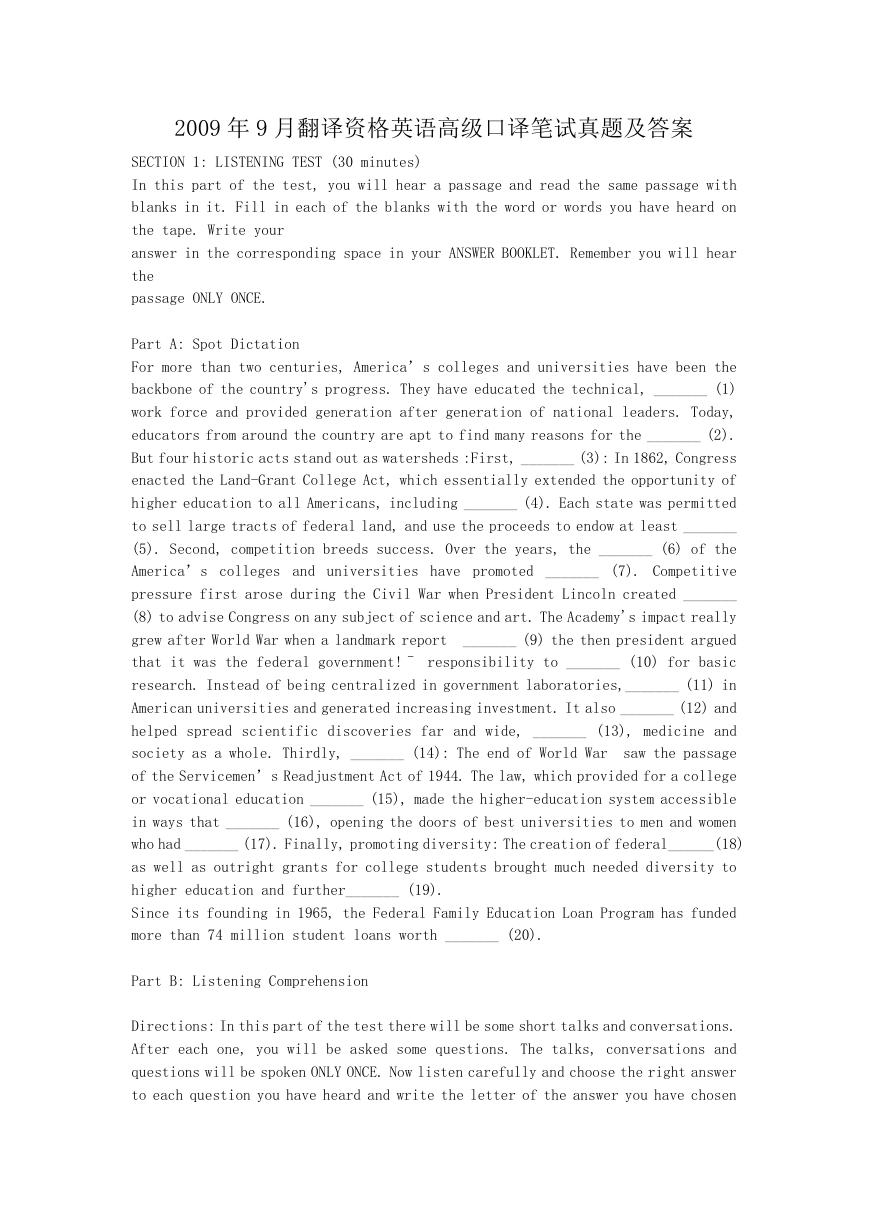
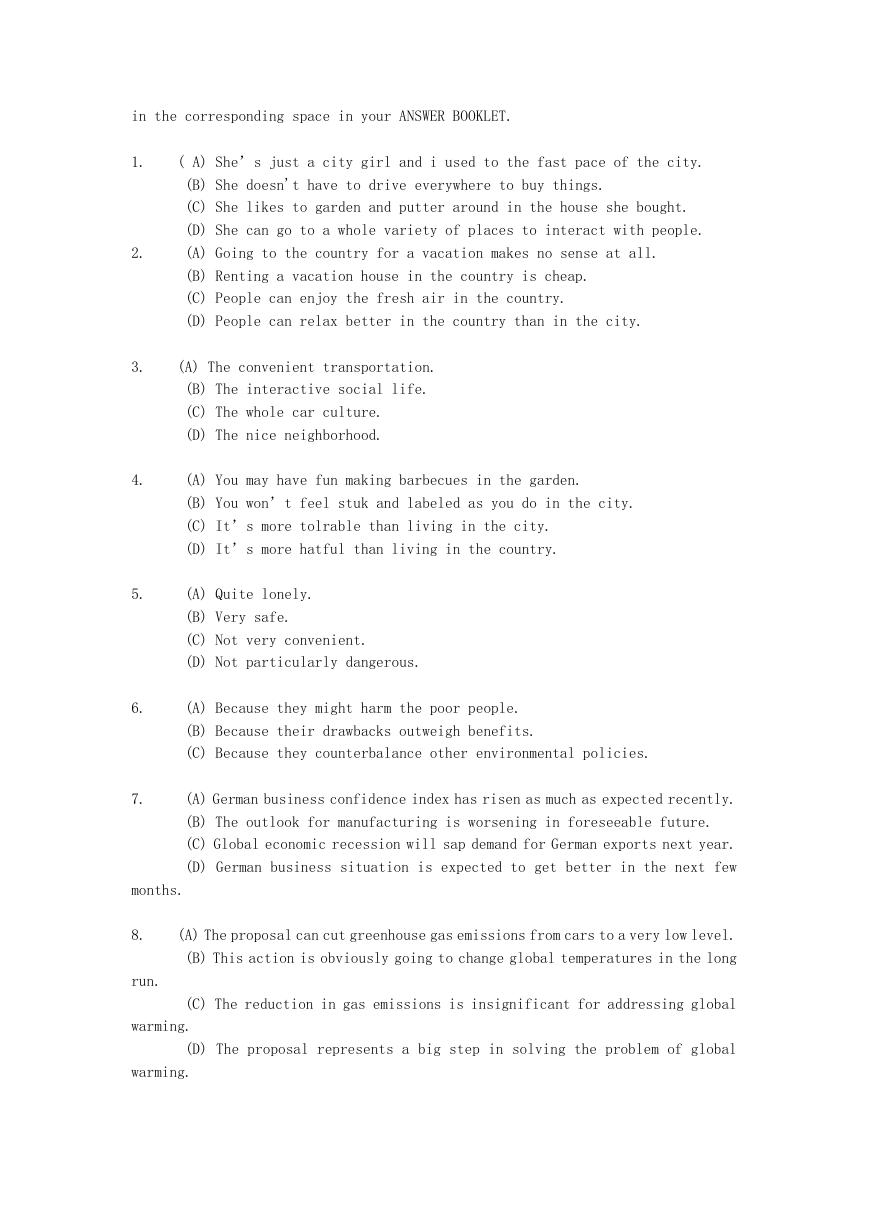
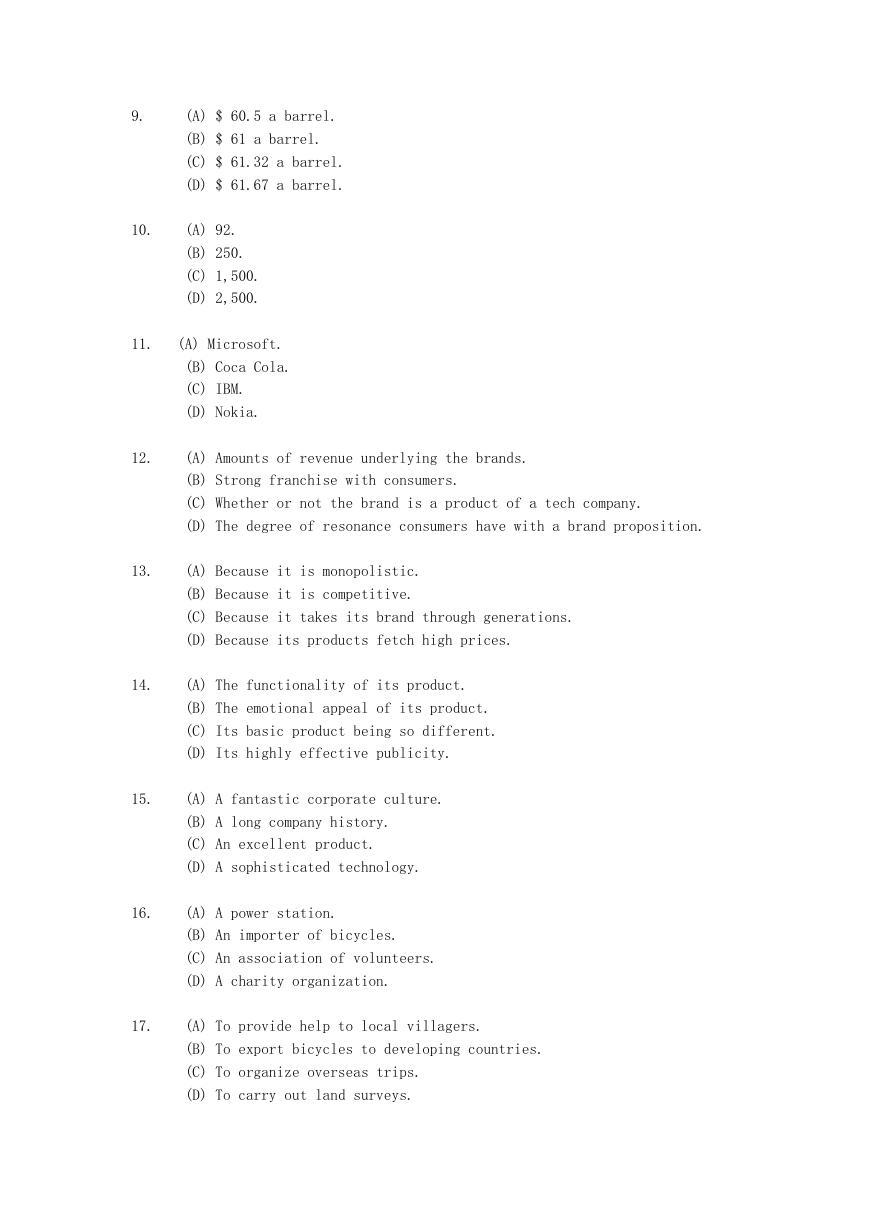
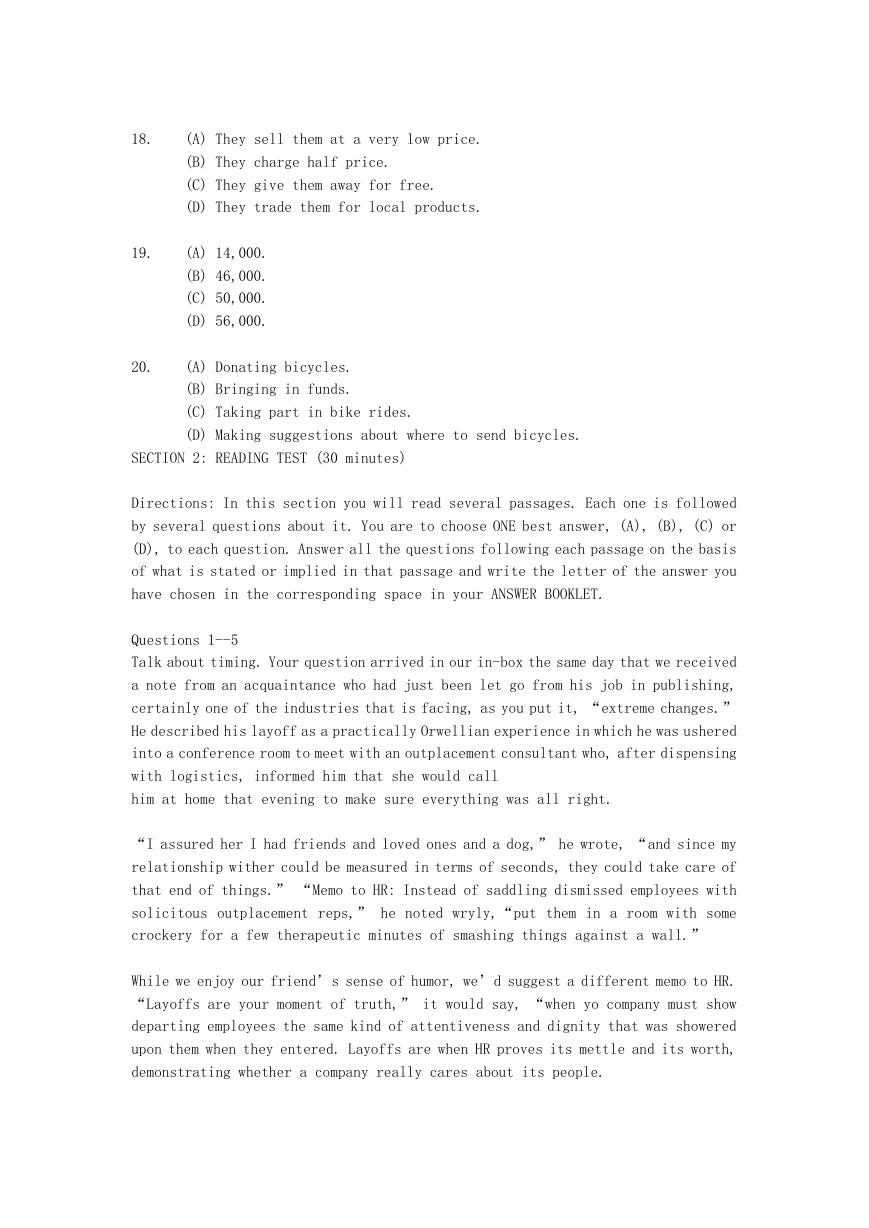
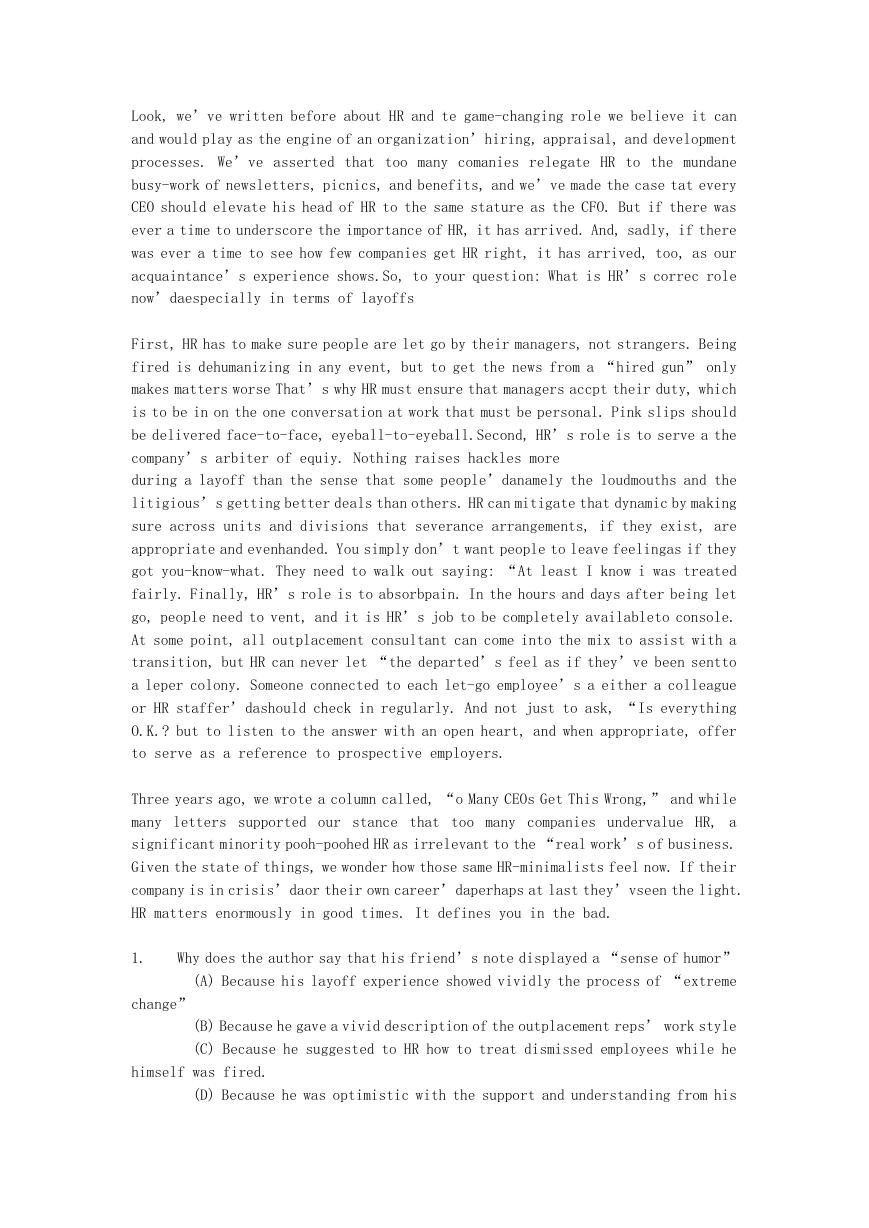
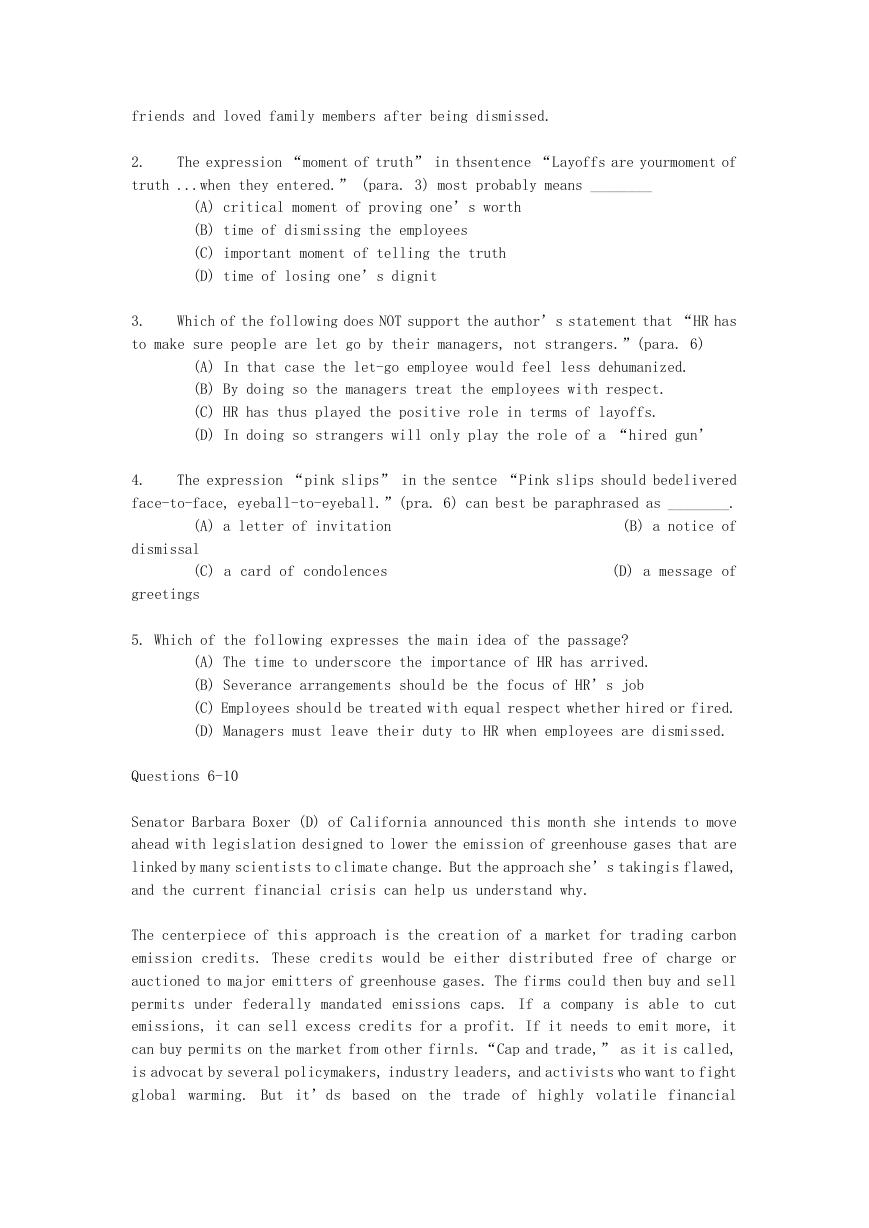
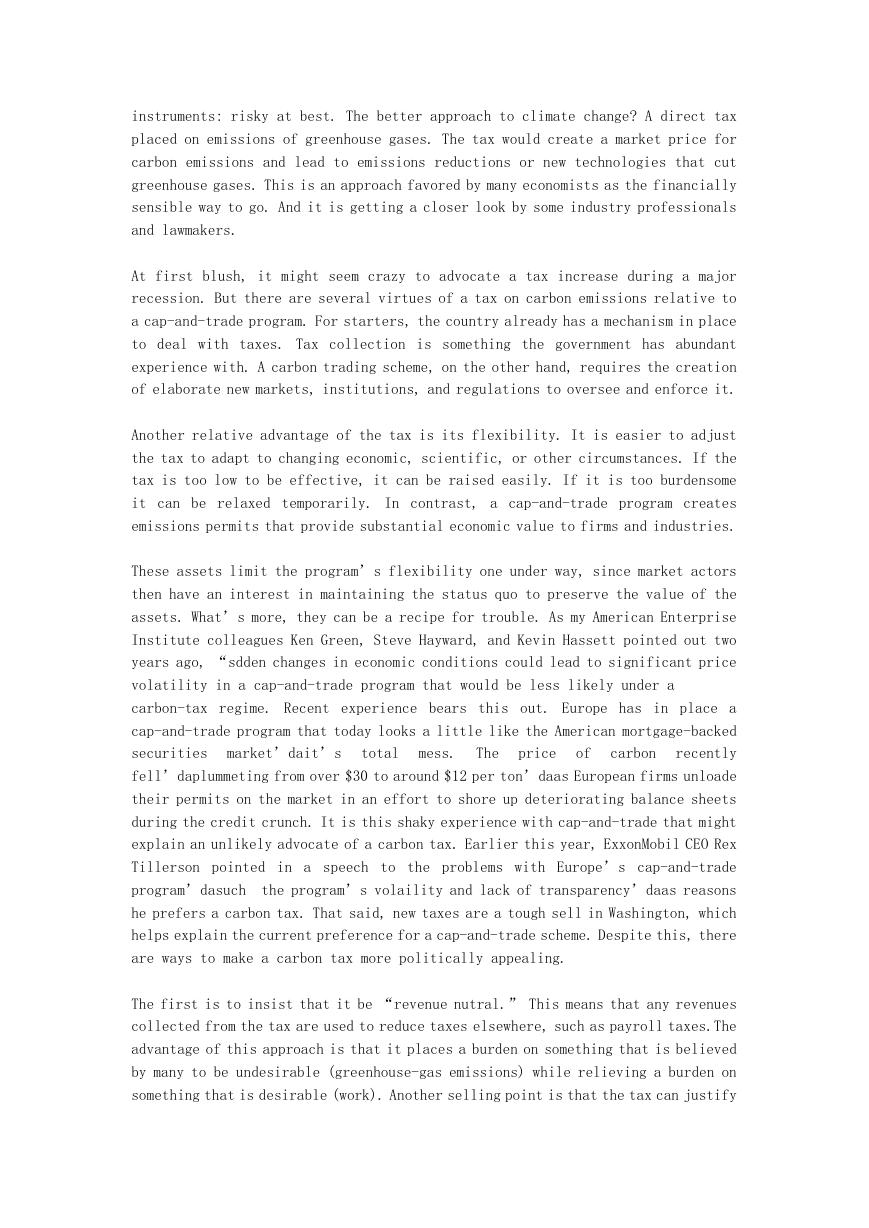
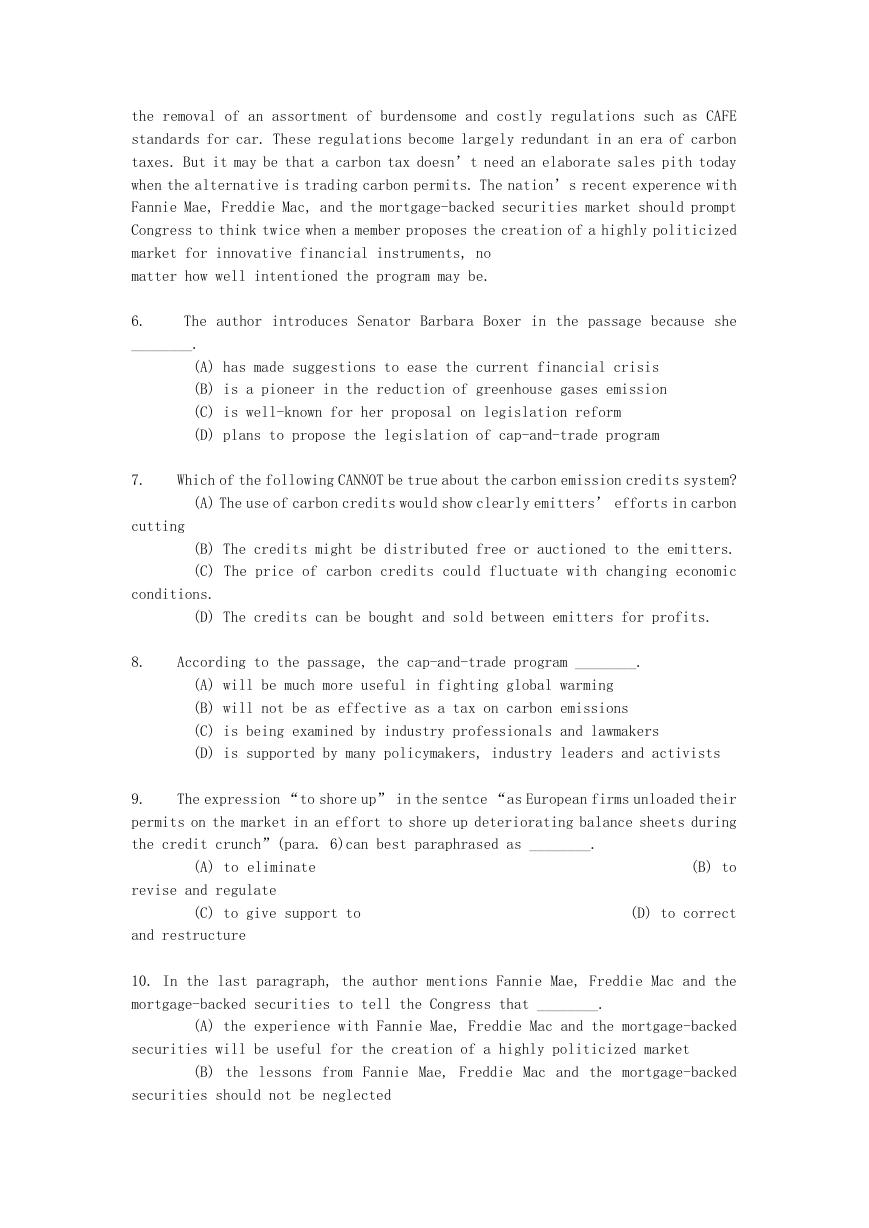








 2023年江西萍乡中考道德与法治真题及答案.doc
2023年江西萍乡中考道德与法治真题及答案.doc 2012年重庆南川中考生物真题及答案.doc
2012年重庆南川中考生物真题及答案.doc 2013年江西师范大学地理学综合及文艺理论基础考研真题.doc
2013年江西师范大学地理学综合及文艺理论基础考研真题.doc 2020年四川甘孜小升初语文真题及答案I卷.doc
2020年四川甘孜小升初语文真题及答案I卷.doc 2020年注册岩土工程师专业基础考试真题及答案.doc
2020年注册岩土工程师专业基础考试真题及答案.doc 2023-2024学年福建省厦门市九年级上学期数学月考试题及答案.doc
2023-2024学年福建省厦门市九年级上学期数学月考试题及答案.doc 2021-2022学年辽宁省沈阳市大东区九年级上学期语文期末试题及答案.doc
2021-2022学年辽宁省沈阳市大东区九年级上学期语文期末试题及答案.doc 2022-2023学年北京东城区初三第一学期物理期末试卷及答案.doc
2022-2023学年北京东城区初三第一学期物理期末试卷及答案.doc 2018上半年江西教师资格初中地理学科知识与教学能力真题及答案.doc
2018上半年江西教师资格初中地理学科知识与教学能力真题及答案.doc 2012年河北国家公务员申论考试真题及答案-省级.doc
2012年河北国家公务员申论考试真题及答案-省级.doc 2020-2021学年江苏省扬州市江都区邵樊片九年级上学期数学第一次质量检测试题及答案.doc
2020-2021学年江苏省扬州市江都区邵樊片九年级上学期数学第一次质量检测试题及答案.doc 2022下半年黑龙江教师资格证中学综合素质真题及答案.doc
2022下半年黑龙江教师资格证中学综合素质真题及答案.doc